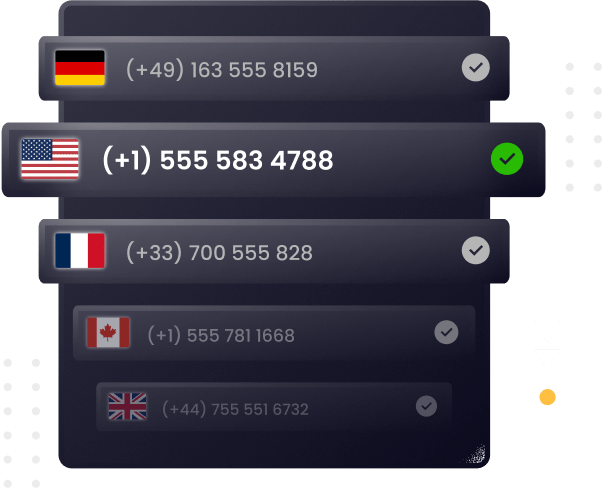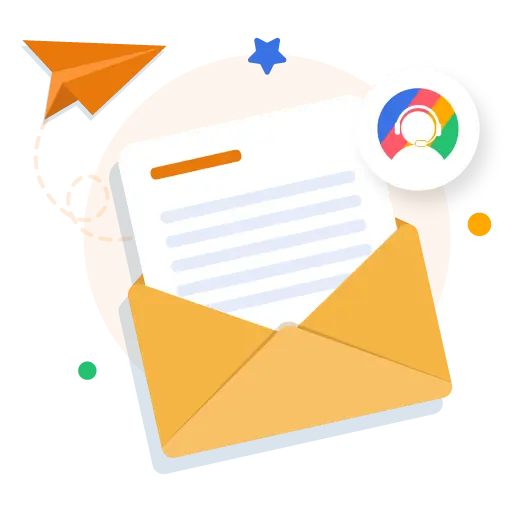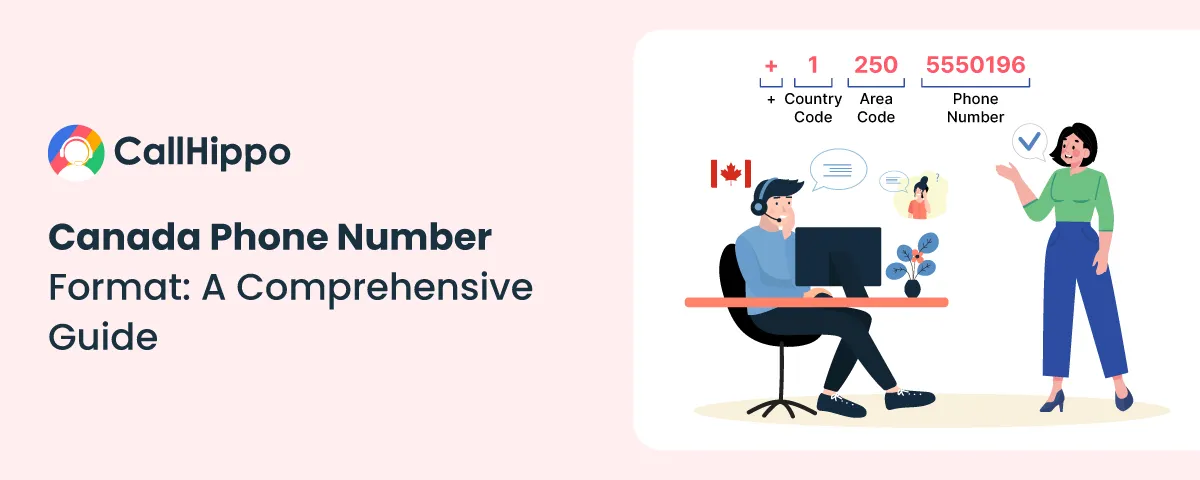If you’ve ever tried dialing a Canada phone number and weren’t sure if you were doing it right, you’re not alone. Understanding the Canada phone number format is essential if you want to connect businesses in the country. A properly formatted Canada number ensures your calls connect without issues, avoids misdials, and helps you establish a professional presence in Canada.
However, with multiple area codes, different types of phone numbers, things can get a little confusing. In this blog, we’ll cover Canadian phone number structure, validity, dialing methods, types, and business benefits to make it easier for you.
What is the Standard Canada Phone Number Format?
A Canadian phone number format follows the NANP structure, which is the same as in the United States and other North American countries.
Here’s a standard Canadian phone number example:
+1 (XXX) XXX-XXXX
Let’s break it down:
- +1 ? This is the Canada country code (also used by the U.S. and other NANP regions).
- XXX ? This is the three-digit area code, assigned based on geographic regions.
- XXX–XXXX ? This is the seven-digit local number, unique to each phone line.
- A valid phone number in toronto, canada could be: 1 416 555 1234. If you are dialing locally within canada, you might not need to be concerned about using “1”. But if you are dialing internationally, use the canada phone code to avoid connection issues.
How to Identify a Valid Canadian Phone Number?
With so many phone numbers, how could you determine if a phone number is valid? Here are a few points to note:
- It follows the NANP format: A valid Canada number should have 10 digits (excluding the country code).
- The area code is real: Canada has over 40 area codes assigned to different provinces and cities. If a number has an area code you do not recognize, it may not be valid.
- It doesn’t start with “1” after the country code: The first digit of the area code must be between 2 and 9. If it is “1,” it is not a valid area code.
It matches a known Canadian phone number list: Many business directories and telecom providers publish lists of registered phone numbers. If a number seems suspicious, you can check it against a Canadian phone number list.
Canada Country Code and Area Codes Explained
Canada uses +1 as its country code. This means when dialing Canada from outside the country, you must start with “+1” before entering the area code and local number.
- Calling a vancouver number from the uk would look like this: +1 604 555 7890
Canadian Area Codes
Canada has 42 area codes, each assigned to specific provinces and territories. When making international calls to Canada, use the same country code (+1) but choose the appropriate area code based on your contact’s location, whether it’s a mobile number or a landline.
Below is a detailed table listing the area codes for Canada’s provinces and major cities. Some of the most commonly used ones include:
| Province | Main Cities | Area Codes |
|---|---|---|
| Alberta | Banff, Calgary, Lethbridge, Medicine Hat | 403, 587, 825, 368 |
| Alberta | Edmonton, Grande Prairie, Jasper, Peace River | 780, 587, 825, 368 |
| British Columbia | Abbotsford, Richmond, Vancouver, Whistler | 604, 778, 236, 672 |
| British Columbia | Victoria | 250, 778, 236, 672 |
| Manitoba | Winnipeg | 204, 431, 584 |
| New Brunswick | Saint John, Moncton | 506, 428 |
| Newfoundland | Single code | 709 |
| Northwest Territories | Single code | 867 |
| Nova Scotia | Single code | 902 |
| Nunavut | Single code | 867 |
| Ontario | Hamilton | 905, 289, 365, 742 |
| Ontario | London, Windsor | 519, 226, 548 |
| Ontario | North Bay | 705, 249, 683 |
| Ontario | Ottawa | 613, 343, 753 |
| Ontario | Thunder Bay | 807 |
| Ontario | Toronto | 416, 647, 437 |
| Prince Edward Island | Single code | 902 |
| Quebec | Quebec City | 418, 581, 367 |
| Quebec | Laval | 450, 579, 354 |
| Quebec | Montreal | 514, 438, 263 |
| Quebec | Gatineau, Sherbrooke | 819, 873, 468 |
| Saskatchewan | Regina, Saskatoon | 306, 639, 474 |
| Yukon Territory | Single code | 867 |
Since some cities have multiple area codes, it’s important to double-check the correct code before dialing.
What is the Best Time to Call Canada?
When contacting someone located in Canada from overseas, it is critical to consider the time zones so that you call at an appropriate hour.
Six time zones are spread across Canada, which means the time will vary considerably depending on where your call is directed.
- If you are calling Toronto (Eastern Time) from London (GMT), there is a 5-hour difference. Similarly, if you call Vancouver (Pacific Time) from Sydney (AEST), it represents a 19-hour time difference, meaning that your morning may be their late evening.
To avoid calling at strange hours, it is generally best to schedule phone calls specifically within business hours or in the early evening (as this is when people are more likely available).
To make it easier, listed here are the time zones in Canada and how they align with Coordinated Universal Time (UTC):
- Newfoundland Time (NT): UTC -3:30
- Atlantic Time (AT): UTC -4
- Eastern Time (ET): UTC -5
- Central Time (CT): UTC -6
- Mountain Time (MT): UTC -7
- Pacific Time (PT): UTC -8
If you are in another country, you can find the best time to call Canada based on your location from below:
Best Calling Hours by Region
1. If you’re in Europe (UTC +1 to +3):
Best time to call: 2 PM – 10 PM
Calls made in this window will reach Canadian contacts between 8 AM – 4 PM in Eastern Canada and 5 AM – 1 PM in Western Canada.
2. If you’re in Asia (UTC +7 to +9):
Best time to call: 6 AM – 2 PM
Calling in this range ensures your call reaches Canada between 4 PM – 10 PM in Eastern Canada and 1 PM – 7 PM in Western Canada.
3. If you’re in Australia (UTC +10 to +12):
Best time to call: Midnight – 8 AM
Since Australia is ahead of Canada by almost a day, calling during this window allows you to reach Canadian contacts during their normal business hours.
To avoid confusion, you can also use a world time converter or schedule calls using online meeting tools like Google Calendar or Microsoft Outlook.
How to Call a Canada Phone Number Using CallHippo?
Calling a Canadian phone number from a reputable provider like CallHippo can help establish a local presence and cut down on fees associated with making calls. Here’s how to get a Canadian virtual phone number at CallHippo:
Step 1: Set Up CallHippo for Your Business
Signing up for CallHippo takes less than three minutes. The platform offers fixed pricing based on the number of users, ensuring cost-effective communication for your team.
Get Your Canadian Phone Number
with CallHippo!
- Get a Local Canadian Phone Number
- Make Calling Simple
- Stay Connected Hassle-free

Step 2: Choose a Canadian Province & Area Code
Once you have signed up with CallHippo, select which province and area code you want your Canada number to be based in. This will help contribute to a local presence in that province.
Step 3: Browse Available Canadian Phone Numbers
Once you have selected the province and area code, CallHippo will generate for you multiple available Canadian phone numbers to check.
Step 4: Select Your Preferred Phone Number & Choose Your Pricing Plan
Choose your Canada phone number based on your business needs. Once you have selected your number, it is now time to choose your price according to your usage. CallHippo has different prices to match your business needs.
Step 5: Start Making Calls
Now that your number is activated, you can immediately start making and receiving calls from your Canada virtual phone number!
With CallHippo, you can easily connect with Canadian customers, get low calling rates, and manage your business communication just like you did while in Canada, with no need for a physical office.
- Approximately 31% of businesses rely on VoIP systems.
Common Issues When Dialing Canadian Phone Numbers & Solutions
Even though you have the correct format for a Canada phone number, you may still find yourself attempting to dial the number and unable to make the call. Here are some commonly seen problems and their solutions:
1. Call Not Connected
Ensure the correct Canada country code ( 1) is included before the area code and local number.
- The number should include the format 1 (area code) xxx xxxx if you are calling from outside of Canada. Many mobile carriers require a country’s exit code before the area code and local phone number are dialed.
- If you are calling from the UK, for instance, the appropriate sequencing is 00 1 (area code) (number).
- If the call still does not connect, check if your rate plan includes international dialing, or if the recipient’s number has a restriction.
2. Incorrect Number Format
Verify that the number is in the right Canadian phone format: 1 (XXX) XXX-XXXX.
- Canadian phone numbers are always ten digits long (not including the one country code).
- Common mistakes are missing digits, additional numbers, or wrong area codes. Some examples:
- 1 416 5555 6789 (too many digits)
- 1 41 655 56789 (wrong area code)
- 1 416 555 6789 (right format)
If you are dialing a toll-free number, keep in mind it will always start with 800, 833, 844, 855, 866, 877, or 888 area code, and it should not have a geographical area code.
3. Calls Dropped
Calls dropping often are mostly caused by unreliable network connections or unstable call quality. You can try these fixes:
- Switch to a better connection: If you are on the mobile network, move to a better signal strength area or switch to your Wi-Fi connection.
- Use a VoIP service like CallHippo: Telecom experts suggest using VoIP services like CallHippo when traditional networks fail due to high international call tariffs.
- Check your mobile balance or persisted call credits: Some prepaid plans limit international calls if you are out of funds.
By following these troubleshooting tips, you will be able to avoid common dialing errors and achieve better quality when calling Canadian phone numbers.
- Businesses can save an average of 50% to 75% by switching to VoIP.by switching to VoIP.
Different Types of Canadian Phone Numbers with Examples
In Canada, a phone number can be formatted differently depending on its usage and function. Whether you call a friend, a business, or an emergency service, understanding the difference in the phone number can help you dial correctly.
1. Local Numbers
There are local phone numbers used for personal or business calls within a designated city or area. They have the same area code but will vary based on the area they are in.
Example: 1 416 555 6789 (Toronto)
2. Mobile Numbers
Mobile numbers function like local numbers but are assigned to cellular networks instead of landlines. Mobile numbers also have area codes but are not limited to a specific location.
Example: 1 647 555 3456 (Toronto mobile)
3. Toll-Free Numbers
Businesses typically use toll-free numbers to allow their customers to contact them without incurring a cost to the customer. These numbers will always start with 800, 833, 844, 855, 866, 877, or 888.
Example:1 800 555 1234
4. Vanity Numbers
Vanity numbers are custom business numbers created to be easier to remember, often using a word rather than numbers. Vanity numbers are helpful for your brand and marketing purposes.
Example:1 888-CALL-NOW
5. Emergency Numbers
These numbers are reserved for emergency purposes for the police, fire, and/or medical services that require urgent attention.
Example:911 (Canada's universal emergency number)
As you understand more about the valid types of phone numbers you are calling, it ensures you are dialling the correct number, for the correct purpose.
How Can Businesses Benefit from a Canadian Phone Number?
A Canada phone number is a remarkable business tool that could allow companies to develop a local presence, enhance customer support, and improve their bottom line. Here’s how businesses benefit from a Canadian phone number:
1. Professional Presence
A local Canadian phone number makes your business appear trustworthy and accessible to Canadian customers. People are more likely to answer calls from local numbers rather than international access codes or unknown numbers.
2. Lower Costs
International calls can be expensive, but having a Canadian phone number allows customers to reach your business without paying high fees. This makes it easier for them to contact you, leading to higher engagement and sales.
3. Global Reach
Even if your business is based outside Canada, you can still expand into the Canadian market with a Canadian virtual phone number. This eliminates the need for a physical office while allowing you to serve Canadian customers effectively.
4. Better Customer Support
Having a Canadian phone number means you can offer local customer support, reducing wait times and improving customer satisfaction. Whether you’re running an e-commerce store, a tech company, or a service-based business, being easily reachable by phone enhances the overall experience for your customers.
Using a Canadian phone number allows businesses credibility, improved cost, and larger market access while interacting with customers seamlessly.
Conclusion
Getting the Canada phone number formatting correct is necessary for effective communication. Be it calling for personal reasons or setting up a business Canada number, having knowledge of the right formatting and calling method will ensure you connect without complications.
If you are looking for a virtual Canadian phone number, CallHippo has excellent features that will help you become easily established in Canada. Now that you have the ins and outs of Canada phone numbers, you are ready to call Canada with confidence! Get started with CallHippo now.
Frequently Asked Questions
1. How do I identify a Canadian phone number format?
A Canadian phone number follows this format: 1 (area code) XXX-XXXX and has a total of 10 digits.
2. What is the difference between a Canadian landline and a mobile number?
A landline phone number has a fixed line and is used for a home/office environment. A Canadian mobile number is wireless and used to have personal or business communication.
3. How can I get a Canadian virtual phone number?
You can get a virtual Canadian phone number from providers like CallHippo that offer a VoIP-based business phone number.
4. Why Does Canada Use +1 as Its Country Code?
Canada uses the 1 country code since it belongs to the North American Numbering Plan (NANP) and 1 is assigned across Canada, the U.S., and several Caribbean countries.

Subscribe to our newsletter & never miss our latest news and promotions.









